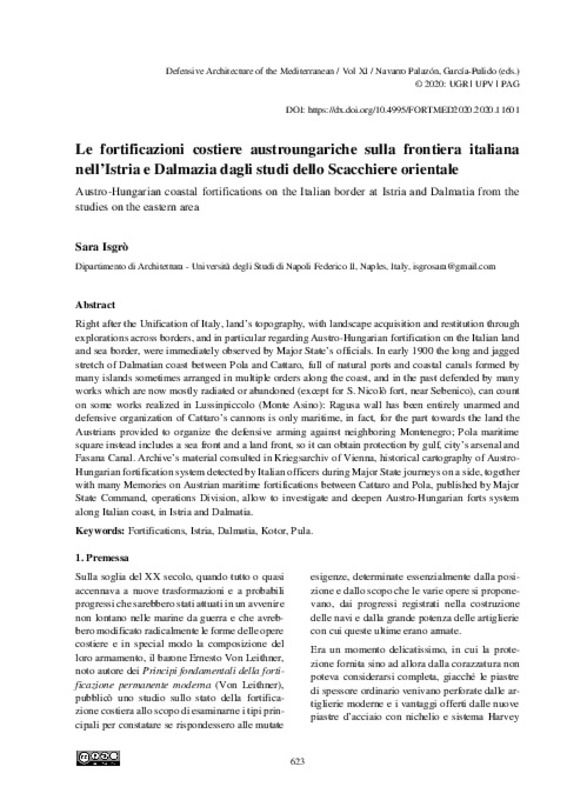JavaScript is disabled for your browser. Some features of this site may not work without it.
Buscar en RiuNet
Listar
Mi cuenta
Estadísticas
Ayuda RiuNet
Admin. UPV
Le fortificazioni costiere austroungariche sulla frontiera italiana nell’Istria e Dalmazia dagli studi dello Scacchiere orientale
Mostrar el registro sencillo del ítem
Ficheros en el ítem
| dc.contributor.author | Isgrò, Sara
|
es_ES |
| dc.date.accessioned | 2020-07-15T09:25:15Z | |
| dc.date.available | 2020-07-15T09:25:15Z | |
| dc.date.issued | 2020-05-15 | |
| dc.identifier.isbn | 9788490488560 | |
| dc.identifier.uri | http://hdl.handle.net/10251/148041 | |
| dc.description.abstract | [EN] Right after the Unification of Italy, land’s topography, with landscape acquisition and restitution through explorations across borders, and in particular regarding Austro-Hungarian fortification on the Italian land and sea border, were immediately observed by Major State’s officials. In early 1900 the long and jagged stretch of Dalmatian coast between Pola and Cattaro, full of natural ports and coastal canals formed by many islands sometimes arranged in multiple orders along the coast, and in the past defended by many works which are now mostly radiated or abandoned (except for S. Nicolò fort, near Sebenico), can count on some works realized in Lussinpiccolo (Monte Asino): Ragusa wall has been entirely unarmed and defensive organization of Cattaro’s cannons is only maritime, in fact, for the part towards the land the Austrians provided to organize the defensive arming against neighboring Montenegro; Pola maritime square instead includes a sea front and a land front, so it can obtain protection by gulf, city’s arsenal and Fasana Canal. Archive’s material consulted in Kriegsarchiv of Vienna, historical cartography of AustroHungarian fortification system detected by Italian officers during Major State journeys on a side, together with many Memories on Austrian maritime fortifications between Cattaro and Pola, published by Major State Command, operations Division, allow to investigate and deepen Austro-Hungarian forts system along Italian coast, in Istria and Dalmatia. | es_ES |
| dc.language | Italiano | es_ES |
| dc.publisher | Editorial Universitat Politècnica de València | es_ES |
| dc.rights | Reconocimiento - No comercial - Sin obra derivada (by-nc-nd) | es_ES |
| dc.subject | Fortifications | es_ES |
| dc.subject | Mediterranean | es_ES |
| dc.subject | Modern age | es_ES |
| dc.subject | Built Heritage | es_ES |
| dc.subject | Istria | es_ES |
| dc.subject | Dalmatia | es_ES |
| dc.subject | Kotor | es_ES |
| dc.subject | Pula | es_ES |
| dc.title | Le fortificazioni costiere austroungariche sulla frontiera italiana nell’Istria e Dalmazia dagli studi dello Scacchiere orientale | es_ES |
| dc.title.alternative | Austro-Hungarian coastal fortifications on the Italian border at Istria and Dalmatia from the studies on the eastern area | es_ES |
| dc.type | Capítulo de libro | es_ES |
| dc.type | Comunicación en congreso | es_ES |
| dc.identifier.doi | 10.4995/FORTMED2020.2020.11601 | |
| dc.rights.accessRights | Abierto | es_ES |
| dc.description.bibliographicCitation | Isgrò, S. (2020). Le fortificazioni costiere austroungariche sulla frontiera italiana nell’Istria e Dalmazia dagli studi dello Scacchiere orientale. Editorial Universitat Politècnica de València. 623-630. https://doi.org/10.4995/FORTMED2020.2020.11601 | es_ES |
| dc.description.accrualMethod | OCS | es_ES |
| dc.relation.conferencename | FORTMED2020 - Defensive Architecture of the Mediterranean | es_ES |
| dc.relation.conferencedate | Octubre 01-03,2020 | es_ES |
| dc.relation.conferenceplace | Granada, Spain | es_ES |
| dc.relation.publisherversion | http://ocs.editorial.upv.es/index.php/FORTMED/FORTMED2020/paper/view/11601 | es_ES |
| dc.description.upvformatpinicio | 623 | es_ES |
| dc.description.upvformatpfin | 630 | es_ES |
| dc.type.version | info:eu-repo/semantics/publishedVersion | es_ES |
| dc.relation.pasarela | OCS\11601 | es_ES |








